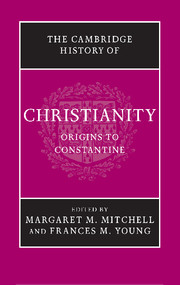Book contents
- Frontmatter
- Prelude: Jesus Christ, foundation of Christianity
- Part I The Political, Social and Religious Setting
- Part II The Jesus Movements
- Part III Community Traditions and Self-Definition
- Part IV Regional Varieties of Christianity in the First Three Centuries
- Part V The Shaping of Christian Theology
- Part VI ‘Aliens’ become Citizens: towards Imperial Patronage
- 28 Persecutions: genesis and legacy
- 29 Church and state up to c.300 ce
- 30 Constantine and the ‘peace of the church’
- 31 The first Council of Nicaea
- 32 Towards a Christian material culture
- Conclusion: retrospect and prospect
- Bibliographies
- Index
- Map 1. The Roman Empire in the time of Marcus Aurelius
- References
32 - Towards a Christian material culture
from Part VI - ‘Aliens’ become Citizens: towards Imperial Patronage
Published online by Cambridge University Press: 28 March 2008
- Frontmatter
- Prelude: Jesus Christ, foundation of Christianity
- Part I The Political, Social and Religious Setting
- Part II The Jesus Movements
- Part III Community Traditions and Self-Definition
- Part IV Regional Varieties of Christianity in the First Three Centuries
- Part V The Shaping of Christian Theology
- Part VI ‘Aliens’ become Citizens: towards Imperial Patronage
- 28 Persecutions: genesis and legacy
- 29 Church and state up to c.300 ce
- 30 Constantine and the ‘peace of the church’
- 31 The first Council of Nicaea
- 32 Towards a Christian material culture
- Conclusion: retrospect and prospect
- Bibliographies
- Index
- Map 1. The Roman Empire in the time of Marcus Aurelius
- References
Summary
Christians, idols and the invisible God
In his address at the Athenian Areopagus, the apostle Paul (according to Luke) points out similarities as well as differences between the worship of the locals and the God he proclaims. Distressed to find the city filled with idols, he remarks that Athenians must be extremely religious people, since, among all those objects of worship, he noted an altar dedicated to ‘an unknown god’.This find leads him to distinguish the Christian God from other gods, specifically in terms of their material accoutrements:
The God who made the world and everything in it, he who is Lord of heaven and earth, does not live in shrines made by human hands, nor is he served by human hands… Since we are his offspring, we ought not to think that the deity is like gold, or silver, or stone, an image formed by the art and imagination of mortals.
(Acts 17: 22-9, NRSV)If Paul’s pronouncement actually had guided subsequent Christian practice, this religion indeed would have appeared to be a ‘strange new teaching’ – radically different from other religions in terms of constructing shrines to house or images to portray its deity. Graeco-Roman polytheism was visually oriented. Temples and statues were central to most of the ‘foreign’ religions practiced by diverse ethnic groups in the empire, while religious pluralism and experimentation were characteristic of the era. Paul’s Athenian contacts are described as eager to hear and tell about ‘something new’, and Paul’s proclamation of a deity beyond visual representation and inhabiting all of space was something new. But besides worshipping their own invisible and omnipresent God, Christians stubbornly refused to respect their neighbour’s gods and boycotted the civic and imperial cult. They were not pluralistic in heir attitude towards religion, and either denied that other gods existed, or claimed that they were demonic inventions.
Keywords
- Type
- Chapter
- Information
- The Cambridge History of Christianity , pp. 568 - 585Publisher: Cambridge University PressPrint publication year: 2006
References
- 3
- Cited by

